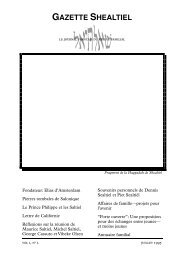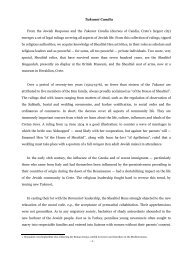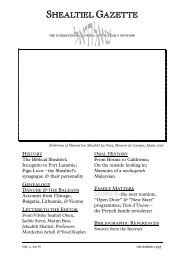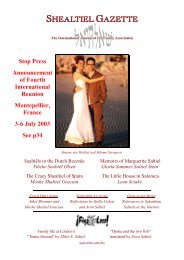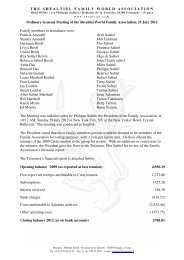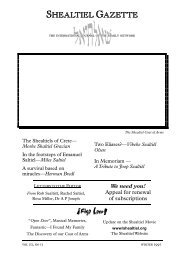a thesis by Flora Jane Satt - Shealtiel
a thesis by Flora Jane Satt - Shealtiel
a thesis by Flora Jane Satt - Shealtiel
Create successful ePaper yourself
Turn your PDF publications into a flip-book with our unique Google optimized e-Paper software.
<strong>Flora</strong> <strong>Jane</strong> <strong>Satt</strong>—annotated <strong>by</strong> Miles Saltieland Julius Schwarz, to discuss plans for their colony, but littlecould be decided until the colonists could see the location. Hartand Schwarz drove the men of the group up Oak Grove Creek toinspect their future homes.Schwarz 2: “Saltiel’s partner”It is not clear that Schwarz was Saltiel’spartner. <strong>Satt</strong>’s sources for this is areunreliable on much else. See Appendix1: A note on sources for an expansionon thisSaltiel had written to the Hebrew Emigrant Aid Society in October,1881 that the twenty houses were finished and that five large barnswould be completed shortly. He listed prices for farm implementsand horses, implying that if these prices met with the approval ofthe Society, the articles would be purchased upon Saltiel’s receiptof their reply. Now, more than seven months later, the newcomersfound only twelve small, poorly-constructed cabins approximatelyeight feet square, six feet high, with flat roofs and no chimneys.They had no doors or windows, nor even the jambs or frames intowhich such might be easily fitted. There was no furniture inside,and only four of the twelve structures possessed stoves for heatingor cooking.Hart pointed out the twenty divisions of land in the valley. Therewas supposed to have been 160 acres in each parcel. Twelve ofthese were located on either side of Oak Grove Creek, the remainingeight farms were marked out beyond a high ridge 8,000 feetabove sea-level. These last were in the Wet Mountain Valley itself,but despite the name, there was no water on the lands. No fencesor other boundaries separated the colonists’ lands, and in the WetMountain Valley sections, the sparse grass which had just begun togrow was being grazed <strong>by</strong> neighboring ranchers’ cattle.On the twelve parcels in Oak Grove Valley there was no sign of anyother improvement save the tiny cabins. No wells had been dug,no fences built and no road cleared. Hart drove the wagon up thestream bed itself, not too steep under normal circumstances, butobviously impassable during spring flood stages or the suddenmountain cloudbursts which often transformed a dry arroyo into aroaring cataract for several hours. The materials for the twelveQuarter sectionsThese 160 acre plots were the standardland grant in Fremont County at thattime, but would have been scanty in theeast and turned out to be inadequate inthe Cotopaxi plateau, better suited forstock-raising than farming. Schwarz’report states that he allocated acreage toeach family on the spot. See Appendix1—A note on sources.DeficienciesSome of the colonists’ complaints seemill-judged. Fences to protect againststrays were called for barbed wire.Schwarz’ report states that this was notinitially to hand (p11), but his accountingindicates that it was subsequentlyobtained (p15). See Appendix 1—Anote on sources). To be fair, wirewould have offered meagre protectionagainst bears, presumably grizzlies,preparing for hibernation (see page 24below). By contrast, as <strong>Satt</strong> acknowledgesa few sentences later, clearing a roadthrough the rubble of the Cotopaxiplateau would have taken gangs of labournot to hand at that point.19



